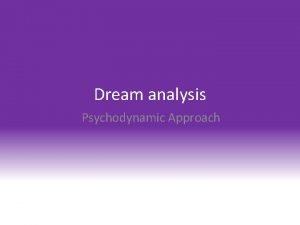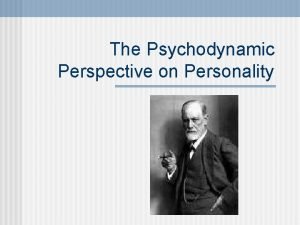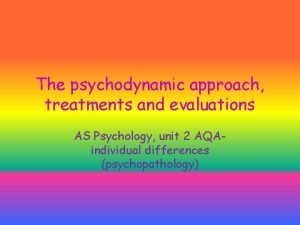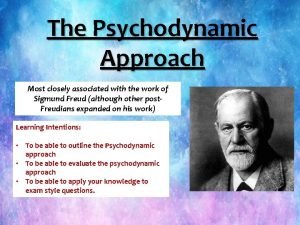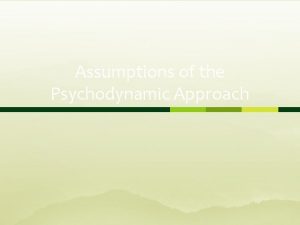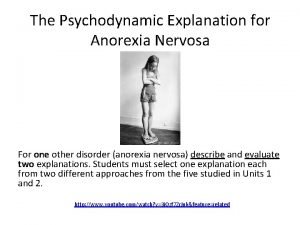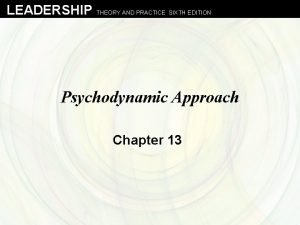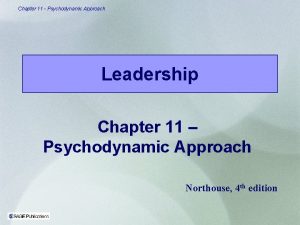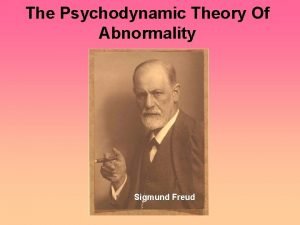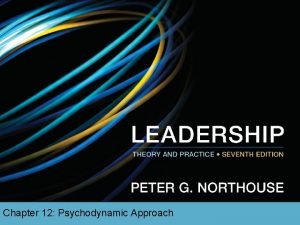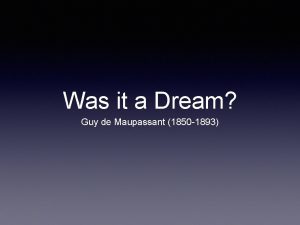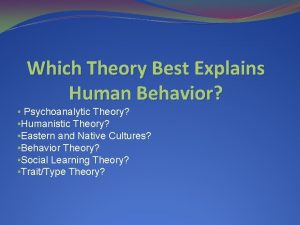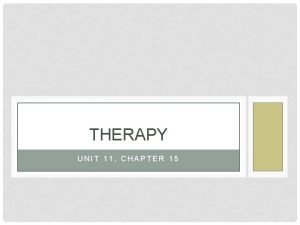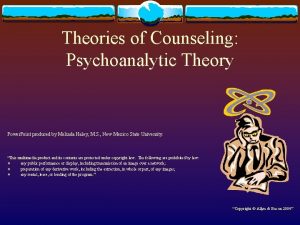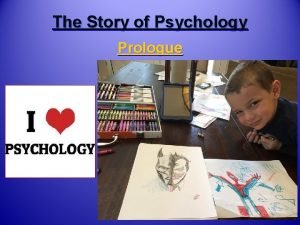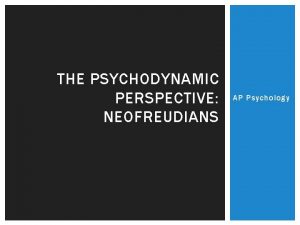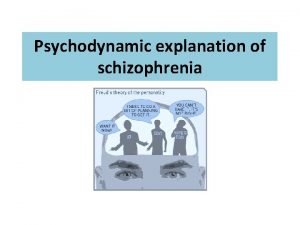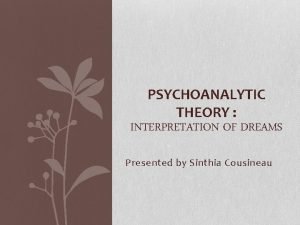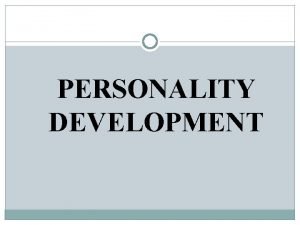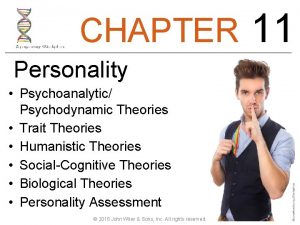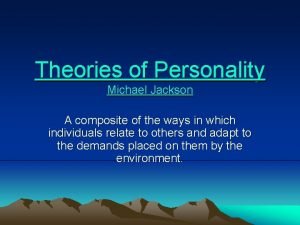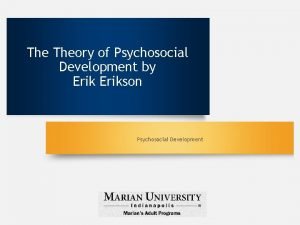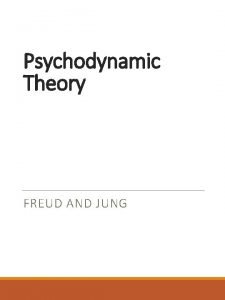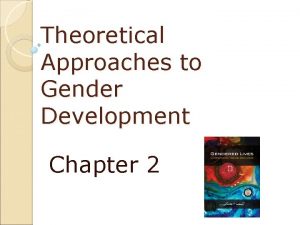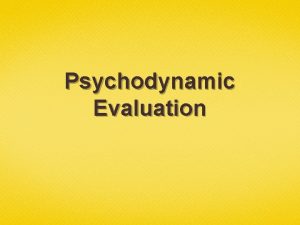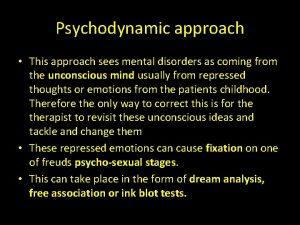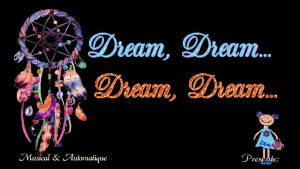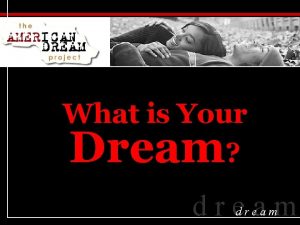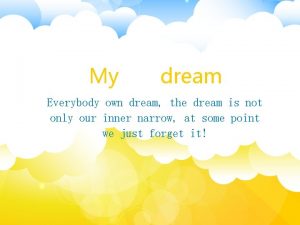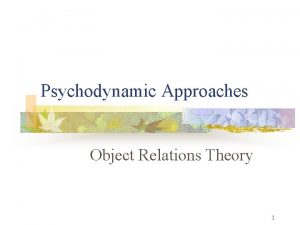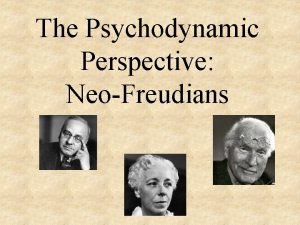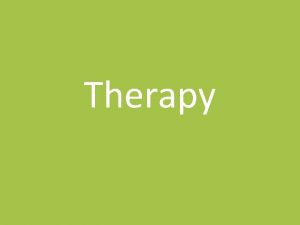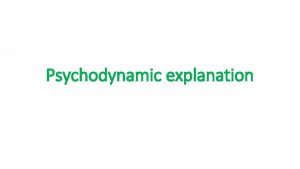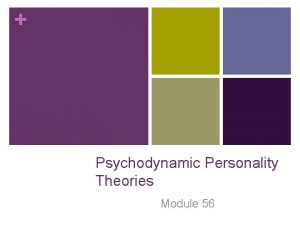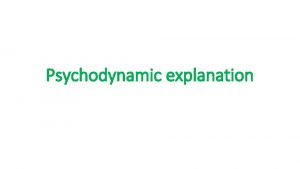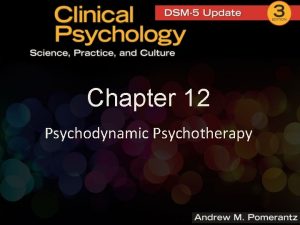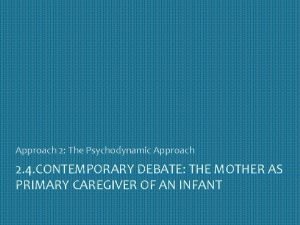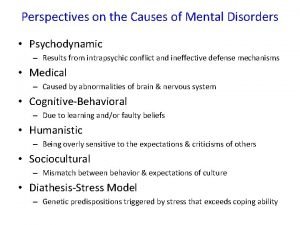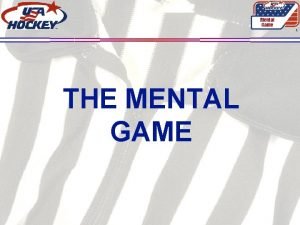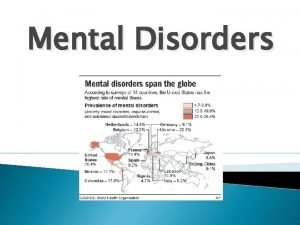Dream analysis Psychodynamic Approach Psychodynamic approach on mental




































- Slides: 36

Dream analysis Psychodynamic Approach

Psychodynamic approach on mental disorders • Mental disorders are said to come from the unconscious mind • Due to repressed thoughts or emotions from childhood

Ice berg theory • the conscious mind, the preconscious, and the unconscious mind—each lying beneath the other. Freud believed that significant psychic events take place "below the surface" in the unconscious mind, like hidden messages from the unconscious. He interpreted such events as having both symbolic and actual significance.

Treatment • In order to treat the mental disorder the analyst must therefore access the patients unconscious mind. • THROUGH DREAM ANALYSIS • • • When we sleep our ego’s defences are more relaxed, so material that usually stays in our unconscious ‘surfaces’ in the form of a dream

HOWEVER! • This material that makes up dreams cannot be let into our conscious mind in its actual form as it may threaten our peace of mind

Content of dreams • The bits we remember are called the manifest content • Whilst what the dream actually means is called the latent content

What the analyst must do… • Uncover the true meaning of the dream • (analyst must have several recordings or dreams to do this-not just 1!) • One way to analyse dreams is via… • FREE ASSOCIATION

Free association • Patient talks about thoughts, emotions and the dreams created, rather than the actual content. • For example- anorexics are asked to talk about early memories to uncover unconscious conflicts that may be causing their disorder. • This allows them to deal with it on a conscious level

Strengths of this approach • Heaton et al (1988) found that clients who had therapists interpreting their dreams felt they got more insight and depth that way than trying to interpret their own. • 88% of clients said they proffered therapists to interpret their dreams- seems to offer clients help. **** KOLCHAKIAN AND HILL 2002

Weaknesses… • Dream analysis is subjective , with the interpretation of the dream dependent on the analyst. Different analysts may have different interpretations. • Client may not tell the analyst the whole dream! May have forgotten bits or might edit certain areas of the dream. May therefore not actually reflect the unconscious mind. ***EYSENECK 1952 **** ESPOSTIO ET AL 1999

COGNITIVE APPROACH • CBT- cognitive behavioural therapy • Combines cognitive and behavioural approaches • Cognitive assumption that our beliefs about the world affect how we see the world and ourselves. • Behavioural part is what changes our behaviour

CBT • Focuses on the present behaviour and thoughts instead of how they are developed • The therapist has to accept the patients perception of reality and then use this misperception to help the patient manage • To make adaptive decisions instead of maladaptive

Strengthsss! • Until recently it was thought that CBT would not be effective for people as their whole perception of reality is different. –making it difficult to get them to challenge their beliefs. • HOWEVER… Chadwick 2000 studied 22 schizophrenics who heard voices. All got 8 hrs of CBT and all had reduce negative symptoms…

• Gould et al 2001 carried out a meta-analysis of studies that looked at the effectiveness of CBT in conjunction with taking anti psychotics. • He found that there wad a large reduction in positive symptoms in most cases, with drop out rates of about 12 %, considerably lower than amongst those who stop taking anti psychotics

Biological approach • Use of drugs…

Antipsychotics • Are also known as neuroleptics, were first developed in the 1950 s… • Helped to sedate person also reduce the intensity and frequency of hallucinations and delusions. • Further anti psychotic drugs have since been developed…

What happens in the brain? • Anti psychotic drugs fit into dopamine receptors … • Blocking dopamine and stopping it being picked up… • Most effective when given at the onset of schizophrenia

• http: //www. youtube. com/watch? v=N 6 NL 41 b REHo

Clozapine • Developed in the 1970 s, also reduce the negative symptoms, though some debate remains as the evidence is inconclusive. . • Some studies found it affective whilst others haven't

Strengths of the biological approachuse of drugs • Drugs allow the patient to live in society, so avoiding being institutionalised. . . • Allows them to access otherapies that may also help to cure them

• Pickar et al 1992 • Compared the effectiveness of clozapine with other neuroleptics and a placebo drug. He found that clozapine was the most effective of treating symptoms, even in patients who did not respond to previous drugs • Placebo was least effective


Emsley 2008 • Studied the effects of injecting the anti psychotic drug ripseridone • Found that those who had the injection early in the course of their disorder had high remission rates and low relapse • In 84% of patients there was at least a 50% reduction in positive and negative symptoms • Over the 2 years of the study-64% went into remission

Weaknesses • One problems with all the drugs is the side effects! • Constipation; coughing; diarrhea; drowsiness; dryness of mouth; headache; heartburn; increased dream activity; increased length of sleep; nausea; sore throat; stuffy or runny nose; unusual tiredness or weakness; weight gain; absence of menstrual periods; breast growth in males; tiredness; increased appetite; sexual problems in both men and women

• Non compliance or partial compliance when it comes to taking the drugs is a major barrier to the treatment of schizophrenia and can lead to relapses. • After several relapses, patients are at an increased risk of never getting back to a functional level they were at before developing the disorder

Rosa et al • Found that only 50% of the patients comply with their drug therapy. • Even if patients do comply and take their drugs, it has been found that 50% of them still have distressing symptoms. • Can never been seen as a cure… as you will always have to take their drugs

Issues • Use of drugs may be unethical as it may create a dependency to them and think that u can treat any problem with drugs… • The use of drugs was shown not to ever ‘cure’ patients and this may be a misleading. • However, taking the drugs allows for sufferers to socialise with people ‘normally’ in every day life

Learning approach • TOKEN ECONOMYYYYYYY A system of behaviour modification based on the systematic positive reinforcement of target behaviour. The reinforces are symbols or tokens that can be exchanged for other reinforces. Token economy is based on the principles of operant conditioning and can be situated within applied behaviour analysis (behaviourism). Token economies are applied with children and adults.

Token economy and anorexia • reward patients for eating regular meals, and ensuring that they do not purge afterwards, with additional hospital privileges or rewards then being granted. • A rewards may be, seeing their families….

Strengths • Although no specialist training is needed to implement a TEP, most experts recommend training for all staff… makes the programmes fair • Gives anorexics a sense of control over their own life and focuses the attention off controlling the idea of being thin to putting on weight. .

Weaknesses • Some people could argue that the programmes can lead to learned helplessness, where anorexics feel they have no choice but to comply otherwise basic privileges are withheld from them. This may be unethical • • May violate human rights? And at the very least is patronising

Social approach • FAMILY THERAPY • Families are usually involved in therapy and recovery from anorexia in various ways. Underlying relationship issues must be dealt with between the anorexic patient and family members

Maudsley • Maudsley Family Therapy, also known as Family-Based Treatment or the Maudsley Approach, is a family therapy for the treatment of anorexia nervosa devised by Christopher Dare and colleagues at the Maudsley Hospital in London in 1985 • Also • ****Lock and Le Grange

Family therapy…. • A comparison of family to individual therapy was conducted with eighty anorexia patients. • The study showed family therapy to be the more effective approach in patients under 18 and within 3 years of the onset of their illness. • Subsequent research confirmed the efficacy of family-based treatment for teens with anorexia nervosa. • Family-based treatment has been adapted for bulimia nervosa and showed promising results in a randomized controlled trial comparing it to supportive individual therapy.

Strengths • FBT encourages parents to take an active role in restoring their adolescent's weight and, for now, seems to have some advantages over the more "routine" advice to parents, which is to involve them in a way that is supportive and understanding of their child, but encourages them to step back from the eating problem.

Weaknesses • Engaging these families in treatment can be a challenge and this may be particularly true when the family is seen together in session. This challenge around engagement might be associated with parental guilt and blame that increase as a consequence of criticisms or confrontations occurring during family sessions.
 Strengths of the psychodynamic approach
Strengths of the psychodynamic approach To dream the impossible dream poem
To dream the impossible dream poem Poem types
Poem types Example of regression defense mechanism
Example of regression defense mechanism Psychodynamic approach
Psychodynamic approach The psychodynamic perspective
The psychodynamic perspective Psychodynamic approach to schizophrenia
Psychodynamic approach to schizophrenia Key assumptions of psychodynamic approach
Key assumptions of psychodynamic approach Anorexia psychodynamic explanation
Anorexia psychodynamic explanation Freud personality types
Freud personality types Psychodynamic approach to leadership
Psychodynamic approach to leadership Psychodynamic approach to personality
Psychodynamic approach to personality Sigmund freud psychosexual stages
Sigmund freud psychosexual stages Psychodynamic approach to leadership
Psychodynamic approach to leadership Mental health and mental illness chapter 20
Mental health and mental illness chapter 20 Mental illness mental health jeopardy
Mental illness mental health jeopardy Dizzee rascal dream analysis
Dizzee rascal dream analysis Dreams by langston hughes theme
Dreams by langston hughes theme Theme of was it a dream by guy de maupassant
Theme of was it a dream by guy de maupassant I will sail my vessel lyrics
I will sail my vessel lyrics Psychodynamic theory
Psychodynamic theory Psychodynamic vs psychoanalytic
Psychodynamic vs psychoanalytic Psychoanalysis
Psychoanalysis Psychology memes
Psychology memes Psychodynamic perspective ap psychology
Psychodynamic perspective ap psychology Psychodynamic personality theory
Psychodynamic personality theory Psychoanalytic theory dreams
Psychoanalytic theory dreams Sigmund freud psychoanalytic theory
Sigmund freud psychoanalytic theory Module 55 psychoanalytic and psychodynamic theories
Module 55 psychoanalytic and psychodynamic theories Psychodynamic vs psychoanalytic
Psychodynamic vs psychoanalytic Defense mechanisms freudian
Defense mechanisms freudian Michael jackson psychodynamic
Michael jackson psychodynamic Psycho social theory of development
Psycho social theory of development Psychodynamic and humanistic therapies have in common
Psychodynamic and humanistic therapies have in common Regression psychology
Regression psychology Ocd psychodynamic perspective
Ocd psychodynamic perspective Theoretical approaches to gender development
Theoretical approaches to gender development
